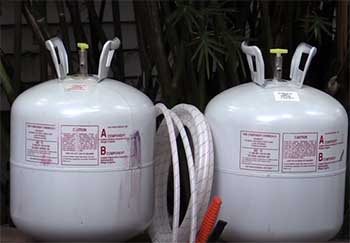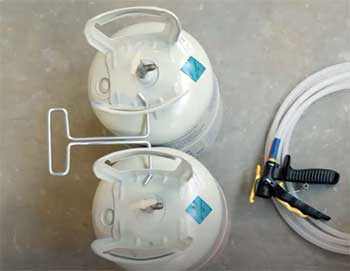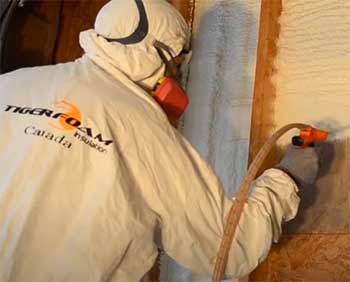When it comes to home insulation, particularly spray foam, choosing the right product can make a significant difference in efficiency, ease of application, and overall performance.
Today, I’ll share my experiences with two popular spray foam insulation options: Tiger Foam and Froth-Pak.
If you’re like me and want your home to be well-insulated while saving on energy costs, this comparison will help you decide which product suits your needs best.
A Brief Comparison Table
| Feature | Tiger Foam | Froth-Pak |
| Application | DIY and professional use | DIY and professional use |
| Types | Quick Cure, Slow Rise | Sealant, Insulation |
| Coverage | Varies by kit size | Varies by kit size |
| R-Value | 6.2 per inch | 6.2 per inch |
| Expansion | High expansion rate | Moderate expansion rate |
| Cure Time | 60 seconds | 30-60 seconds |
| Ease of Use | Moderate | Easy |
| Price | Mid-range | Higher |
| Durability | High | High |
| Environmental Impact | Low VOCs | Low VOCs |
| Reusability | Yes, with proper storage | Yes, with proper storage |
| Customer Support | Excellent | Good |
Tiger Foam: Features and Benefits
Tiger Foam has been a reliable name in the spray foam industry for years. They offer a variety of products tailored for different needs, including Quick Cure and Slow Rise foam kits. Here’s what stood out to me:
Pros

- High Expansion Rate: One of the first things I noticed about Tiger Foam is its impressive expansion rate. This makes it ideal for filling larger gaps and cavities quickly.
- Durability: Once cured, Tiger Foam creates a rigid and durable insulation layer. It stands up well to temperature fluctuations and doesn’t degrade easily.
- R-Value: With an R-value of 6.2 per inch, it provides excellent thermal insulation, helping to keep homes warm in winter and cool in summer.
- Versatility: Whether you’re looking to insulate walls, roofs, or floors, Tiger Foam has a product suited for the job. The Quick Cure is perfect for immediate insulation needs, while the Slow Rise is ideal for areas requiring more controlled expansion.
- Environmental Considerations: Tiger Foam prides itself on low VOC emissions, making it a more environmentally friendly choice compared to some other spray foams.
Cons
- Application Difficulty: While not overly complicated, using Tiger Foam does require some practice to get the application just right. Beginners might find it a bit challenging initially.
- Price Point: Although not the most expensive on the market, Tiger Foam is priced mid-range. Considering its features, it’s a fair price, but budget-conscious users might find it slightly on the higher side.
- Cure Time: With a cure time of about 60 seconds, you need to work relatively quickly. This can be a bit stressful for first-timers.
Froth-Pak: Features and Benefits
Froth-Pak, manufactured by Dow, is another heavy hitter in the spray foam market. It’s known for its ease of use and reliable performance. Here’s what I found with Froth-Pak:
Pros

- Ease of Use: Froth-Pak is designed with the user in mind. The application process is straightforward, making it ideal for DIY enthusiasts.
- Quick Cure Time: With a cure time of 30-60 seconds, Froth-Pak allows you to move through your project quickly, which is a huge plus when you’re working against the clock.
- Moderate Expansion Rate: Froth-Pak’s expansion rate is moderate, providing a controlled application that reduces the risk of over-expanding and wasting product.
- Versatile Product Line: Froth-Pak offers both sealant and insulation foam kits, catering to different project needs. The sealant is perfect for small gaps and cracks, while the insulation foam is ideal for larger areas.
- Consistent Quality: Over multiple uses, I found Froth-Pak to consistently provide a high-quality, durable insulation layer. It’s reliable and does what it promises.
- Customer Support: Dow offers good customer support, which is crucial if you run into any issues during your project.
Cons
- Price: Froth-Pak tends to be on the higher end of the price spectrum. While the quality justifies the price, it might not be the best choice for those on a tight budget.
- Environmental Impact: Although it’s low in VOCs, it’s not the lowest in the market. Those who are extremely environmentally conscious might want to explore other options.
- Storage Requirements: Froth-Pak needs to be stored properly to maintain its usability. If not stored under the right conditions, the product can become less effective over time.
Detailed Comparison of Tiger Foam And Froth-Pak
- Application and Ease of Use

In terms of application, Froth-Pak takes the lead for beginners.
The straightforward instructions and user-friendly design make it a breeze to use, even if you’ve never handled spray foam before.
On the other hand, Tiger Foam requires a bit more finesse.
While not overly complicated, it does have a learning curve, and first-time users might need a few practice runs to get it right.
- Performance and Efficiency
Both products boast an impressive R-value of 6.2 per inch, which is excellent for thermal insulation. This high R-value ensures that both Tiger Foam and Froth-Pak provide superior insulating properties, making your home more energy-efficient.
However, Tiger Foam’s high expansion rate can be advantageous in filling large gaps quickly, whereas Froth-Pak’s moderate expansion offers more controlled application, reducing the risk of overspray.
- Durability and Longevity
Durability is a critical factor when choosing spray foam insulation, and both Tiger Foam and Froth-Pak score high marks here. Tiger Foam creates a rigid, durable layer that withstands temperature fluctuations well.
Similarly, Froth-Pak provides a consistent, high-quality insulation layer that remains effective over time. In my experience, both products hold up well under various environmental conditions.
- Environmental Considerations
If you’re environmentally conscious, both Tiger Foam and Froth-Pak offer low VOC emissions, making them relatively eco-friendly choices. However, Tiger Foam has a slight edge with its lower overall VOC content, making it a bit more appealing for those prioritizing environmental impact.
- Cost
Cost is always a significant consideration. Froth-Pak is on the higher end, which might deter budget-conscious users. Tiger Foam, while not the cheapest, offers a mid-range price point that balances cost with performance.
For those willing to invest a bit more for ease of use and quick application, Froth-Pak might be worth the extra expense.
Frequently Asked Questions (FAQ)
The best spray foam insulation depends on your specific needs. Froth-Pak is excellent for ease of use and quick application, while Tiger Foam is great for high expansion needs and cost efficiency. Both provide superior insulation with an R-value of 6.2 per inch.
Froth-Pak offers both sealant and insulation products. The sealant is designed for filling small gaps and cracks, while the insulation foam is intended for larger areas requiring more substantial insulating properties.
Froth-Pak uses a polyurethane foam, which is known for its durability and excellent insulating properties. It provides a quick and efficient solution for both sealing and insulating.
In terms of durability and insulating properties, both Tiger Foam and Froth-Pak are strong contenders. They both create a rigid, durable layer with high R-values, ensuring long-lasting performance.
Wrapping Up
Choosing between Tiger Foam and Froth-Pak ultimately comes down to your specific needs and preferences. If you’re looking for ease of use and don’t mind spending a bit more, Froth-Pak is an excellent choice. Its user-friendly application and quick cure time make it ideal for DIY projects.
However, if you need a high expansion rate and are comfortable with a slightly more complex application process, Tiger Foam offers a cost-effective and durable solution.
Personally, I found both products to be reliable and effective. The choice boils down to whether you prioritize ease of use or cost efficiency.
Whichever product you choose, both Tiger Foam and Froth-Pak will provide the quality insulation you need to make your home more energy-efficient and comfortable.
